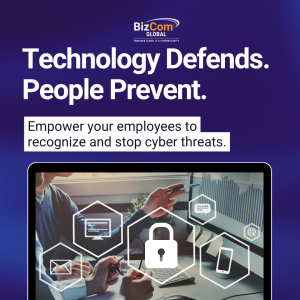
Technology is evolving at lightning speed, and so are the tactics of cybercriminals. Firewalls, intrusion detection systems, and endpoint protection tools are powerful, but there’s one factor that consistently determines whether an attack succeeds or fails: people.
The reality is simple—employees are the front line of cybersecurity. And without awareness training, they’re also the most vulnerable point in your defenses.
A perfect example came from the MGM Resorts cyberattack in September 2023, where a group known as Scattered Spider—affiliated with the ALPHV/BlackCat ransomware gang—brought hotel operations, slot machines, and reservation systems to a standstill. The attackers didn’t exploit a technical flaw; they picked up the phone. Using social engineering tactics known as vishing, they impersonated MGM staff, tricked IT help-desk employees into resetting credentials, and gained access to critical systems through compromised Okta and Microsoft Azure accounts.
The result? Tens of millions of dollars lost each day of the outage, ultimately costing the company around $100 million. And it all started with a single, convincing phone call.
That’s how easily human vulnerability can override even the most sophisticated security systems.
Let’s explore why awareness training matters, the risks of overlooking it, and how businesses can turn their teams into an effective shield against today’s cyber threats.
The Human Factor in Cybersecurity
Cybersecurity reports from IBM, Verizon, and Microsoft all point to the same truth: the majority of breaches—some estimates as high as 88%—can be traced back to human error.
Why do attackers go after people? Because it’s easier than breaking through hardened technology. Crafting a convincing phishing email or a fake text message is faster and cheaper than trying to hack into secure systems. And once an employee clicks, the doors are open.
Some of the most common mistakes employees make include:
- Clicking on phishing links or downloading malicious attachments.
- Using weak, recycled, or easily guessed passwords.
- Oversharing personal or company information on social media.
- Ignoring software update prompts.
- Falling victim to social engineering tactics over email, phone, or text.
Hackers know that employees are busy, distracted, and sometimes under pressure to respond quickly. That’s why they design attacks that look urgent, credible, and familiar. And without training, employees often can’t tell the difference.
The Business Impact of One Mistake
It only takes one.
One click, one attachment, one password entered into a spoofed login page can have a ripple effect across an organization. The consequences include:
Data loss or theft: Sensitive customer or financial data can be stolen in seconds.
Operational downtime: Systems can be locked by ransomware or overwhelmed by malware.
Financial damage: Costs include remediation, legal fees, fines, and lost revenue.
Reputational harm: Customers lose trust when a business can’t protect its data.
- Compliance penalties: Regulatory bodies can impose fines if training and protections weren’t in place.
A real-world example: in 2023, a U.S. healthcare provider suffered a breach when an employee clicked a malicious link. The result? Over 500,000 patient records were exposed, and the organization faced both financial penalties and a loss of community trust.
That incident didn’t happen because technology failed—it happened because awareness failed.
Why Awareness Training Works
The good news is that employee awareness training is highly effective. When staff know what to look for, they are far less likely to fall for malicious attempts—and more likely to report them.
Here’s why it works:
Recognize and resist: Employees learn to spot phishing attempts, social engineering, and suspicious requests.
Reduce overall risk: Every employee becomes a sensor, strengthening your security posture.
- Build a culture of vigilance: Security stops being “IT’s job” and becomes a shared responsibility.
Organizations that run ongoing phishing simulations see dramatic improvements in resilience. For example, companies often reduce their “phish click rate” from 20% to under 5% within months of consistent training and testing.
It’s important to highlight that training can’t be a one-and-done PowerPoint. Threats change constantly, and employees forget what they don’t practice. The most effective programs are continuous, engaging, and tailored to real-world scenarios.
Compliance and Recordkeeping: The Overlooked Benefit
Many industries—including healthcare, finance, and government contracting—require proof of cybersecurity awareness training. Regulators don’t just want to see that you have technology in place; they want to see evidence that your employees are educated and that records are kept.
Without documentation, even the best training effort might not count in the eyes of regulators. That can lead to penalties or impact your ability to win contracts.
Strong awareness training programs deliver dual value: they reduce risk and create a verifiable trail of compliance. That means when an audit happens, you have more than a policy—you have proof.
Introducing CyberSafe 360: Awareness Made Manageable
At BizCom Global, we’ve seen too many organizations struggle to balance security and simplicity. That’s why we created CyberSafe 360, a managed solution that takes the guesswork out of awareness training.
Here’s what it includes:
Ongoing employee education with engaging, easy-to-understand modules.
Simulated phishing campaigns that help employees practice spotting threats.
Record keeping for compliance that satisfies auditors and regulators.
- Actionable reporting so leaders can see progress and spot areas of concern.
Instead of adding more to your IT team’s plate, CyberSafe 360 runs in the background—strengthening your workforce, proving compliance, and giving you peace of mind.
Because the truth is, no matter how advanced your technology, your business is only as strong as its most distracted employee.
What Business Leaders Can Do Now
If you’re wondering whether your organization is prepared, here are three questions to ask yourself today:
- Do my employees know how to recognize a phishing email?
- Could I provide regulators with proof of awareness training if asked?
- Do I feel confident that human error isn’t my biggest vulnerability?
If the answer to any of those is “no,” it’s time to strengthen your front line.
Cybersecurity isn’t just about tools—it’s about people. Awareness training turns your employees from potential risks into your greatest defense. It reduces mistakes, builds confidence, and protects your organization from both everyday attacks and catastrophic breaches.
The threats aren’t slowing down, but neither is your ability to prepare.
Ready to make your team your strongest shield? BizCom Global’s CyberSafe 360 delivers ongoing awareness training, phishing simulations, and compliance-ready recordkeeping—without adding work to your plate.
Learn more about CyberSafe 360 and protect your business today.


